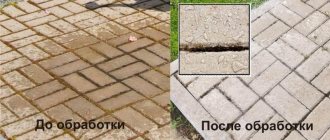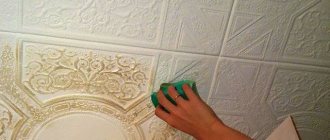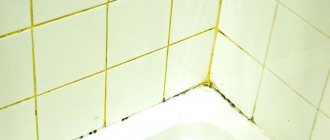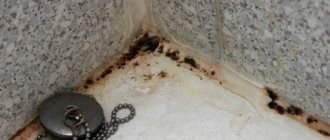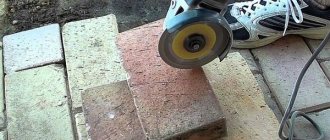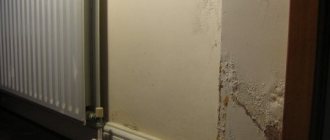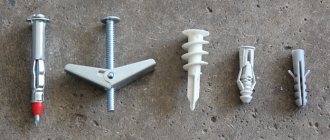Assessment of the quality of old coating
The dismantling process directly depends on how the old coating was laid. Cement-based mortar mixtures provide much stronger adhesion to the substrate than glue. In this case, to remove tiles from the wall, you will need a hammer drill and certain skills in working with it.
If the tiles are laid with regular glue, everything is much simpler - just a hammer and chisel. If you really want to, you can save the old tiles, but to do this you will have to do everything very carefully.
Preparatory stage
So, we have work clothes and safety precautions have been successfully observed. The next step before removing tiles in the bathroom is preparation - purchasing the necessary tools for the person removing the tiles:
- bit;
- hammer;
- chisel;
- perforator;
- drill, set of drills;
- spatula with a wide pointed blade;
- scraper;
- angle grinder;
- sandpaper;
- glue solvent;
- spray;
- pure water.
Additionally, you will need a stepladder and thick film. Before work, you need to cover objects inside the room with it. Not only plumbing, but also pipes and cabinets.
How to remove tiles in the bathroom, what to do? For accuracy, use a chisel. It will be long and tedious (prying up the tiles one by one), but the tiles will remain intact. If only speed is important in dismantling, a grinder or a regular hammer drill is more effective.
Important! Be sure to cover the room's furnishings, including the floor, with protective film. The plumbing will remain unharmed and clean.
Preparing for the dismantling process
Do not forget that any dismantling is always accompanied by a huge amount of dust and fragments. This is especially important in the bathroom, since modern plumbing fixtures are made from fragile materials that are easy to damage. Therefore, you need to prepare to free the walls from old tiles.
- Cover the floor with plastic film in 2 layers.
- We protect all fragile surfaces - bathtub, toilet, sink, etc. - with soft pads (you can wrap them in unnecessary rags, an old towel or blanket) and cover them with film.
Advice
All further work must be carried out only using personal protective equipment: a respirator, a protective suit and special glasses. Hands should be protected with gloves, and feet should be shod in closed boots with hard toes.
Dismantling process
The first thing you need to do when getting started is to find a weak spot in the uppermost tile on the right (for left-handers, follow all instructions in a mirror manner). To do this, gently tap its surface with a hammer. Having found the voids, using a chisel and hammer, we break off a piece of the product.
Advice
It is advisable to tap the entire surface and dismantle areas with voids first. Otherwise, it may suddenly collapse (sometimes in entire sections).
If no voids are found, use a cutter to cut the tiles diagonally, completing further dismantling with a hammer and chisel.
Once the first slab is removed, the rest of the process will be easier. Here are the step-by-step instructions.
- Wet the seams thoroughly with a sponge dipped in warm water. Let the grout paste soak.
- Remove the grout paste from the joints without damaging the edges (it is convenient to use a spatula or screwdriver for this). The topmost row is removed first - and so on in order to the very bottom. The more carefully this stage is carried out, the easier the further process will go.
- The chisel is inserted into the seam between the top and next rows so that the top tile can be pryed off. Here it is important to feel the correct angle, usually it is about 45. The chisel acts as a wedge between the wall and the coating. First, we try to insert a chisel and make a small notch in the wall approximately in the middle of the end of the tile, then on the left and right (closer to the edges of the product). Having made the indentations, we again insert the chisel into the middle.
- Lifting the tile, we separate it from the wall. It doesn't always work out easily the first time. Then a hammer comes to the rescue. You need to hit the chisel several times, each time increasing the force a little. At the same time, you need to try to remove (knock off) the tiles from the wall. Sooner or later it will give in - or only a piece will break off. In the latter case, it is worth resorting to using the cutter again. We cut the remains of the old tiles diagonally and use a chisel (or, in extreme cases, a hammer drill) to finish the job.
Advice
Painting tape, pasted in several layers, will protect the edges of the tile from damage, and it can be used in the future.
- If the task is not to preserve ceramic tiles, the work can be done much faster using a hammer drill with a special attachment. In this case, it is advisable to dismantle from top to bottom and from left to right. Using a power tool significantly speeds up the process.
- After dismantling the ceramic coating, the remaining adhesive or mortar is removed using a scraper. There are also special compounds that make this work easier.
We recommend: 4 ways to protect your gas stove from grease
The cleaned wall surface is treated with a deep penetration primer, and after it has dried, the surface can be used for further finishing.
Particularly difficult cases
In some cases, it is not possible to dismantle the tiles in this way. Let's take a closer look at them.
Removing tiles from a plasterboard wall
If the tile was laid directly on drywall, it will not be possible to knock it down. You will have to completely dismantle the partition. But there are situations when a plasterboard wall was first plastered, and only then a layer of tiles was laid. In this case, there is a chance to remove only the coating.
Step-by-step instruction
- Remove grout using a knife or spatula. It is important to completely clean the seam.
Advice
If you cannot clean the seam, you can lightly cut it with a grinder at an angle of 45 to the center of the tile and remove the residue with a spatula. The depth of the cut should be 1–2 mm greater than the thickness of the tile, otherwise it will crack during dismantling. The assistant at this moment turns on and holds the vacuum cleaner, which sucks up dust, preventing it from scattering throughout the room.
- Use warm soapy water to soak the glue or cement mortar.
- Use a chisel or chisel to pry up the tile and carefully remove it. The tile is removed along with the plaster; the remains are quickly cleaned off using a scraper.
- Prime and putty the drywall.
This method will help preserve the partition, reducing labor intensity and lowering the cost of dismantling.
Removing tiles with metal hooks
Using a chisel and hammer, much less a hammer drill, is not convenient everywhere. In hard-to-reach places, two metal staples made from old screwdrivers or knitting needles bent in a U shape will help.
Once the seams are cleaned and the surface under the tile is sufficiently wet, insert one edge of the hook under the tile from below, and the edge of the other hook from above - and pull it towards you. This method is especially convenient when the tiles were laid correctly, using special glue. It will also help not to spoil the appearance of the product and will make it possible to use the finishing material in the future.
We recommend: What to make from leftover linoleum at the dacha: 5 useful ideas
How to remove ceramic tiles?
Any renovation work in a house means not only updating the interior, but also destroying the old design of the room. Removing coverings from the ceiling or wallpaper from the walls is a difficult task, but necessary to apply new materials and update the room. Ceramic floor tiles are removed much less often than other covering options, but someday their turn comes.
Overdue repairs
The work of removing tiles from the floor is quite labor-intensive; it should be carried out by a person who is ready for physical labor and does not suffer from allergies, since during dismantling there is usually a lot of dust in the air. The removed coating itself is heavy, which means that taking it to a landfill will also require a lot of effort.
Removing floor tiles
However, in some situations, the tiles should remain intact after dismantling. Usually the need to preserve it arises if the material has not yet lost its appearance and can be used elsewhere (for example, in the country).
On a note! If you plan to install heated floors in the bathroom, the tiles will also have to be dismantled and then replaced or replaced with new ones.
Good old ceramic tiles
The timing and complexity of the work will help determine the composition on which the material is based. It can be:
- old cement-sand composition , which was widely used for laying tiles during the Soviet era. Now it is not used, but we must pay tribute - the tiles on it hold very tightly. There is a chance to remove the material from such a composition intact, but it is minimal, so you will have to prepare for the worst. Only using water-salt solutions will help soften this adhesive mixture from the removed tiles - they will have to soak the dried composition for a long time. If they do not help, then an acidic product sold in specialized stores will come to the rescue.
Preparation of cement mortar for tiles
- glue for ceramics . A reliable and modern composition has been used for repair work on tiles for about 25 years. It is more flexible and the chances of keeping the floor elements intact during dismantling are significantly increased.
Removing tiles with a hammer and spatula
Prices for Tarkett floor tiles
Tarquette floor tiles
Safety precautions
During dismantling work, it is very easy to get injured or damage communications running in the wall. To prevent this from happening, you must follow the following rules.
- Check the location of pipes and other communications, especially electrical wiring, and use maximum caution in these areas. The use of power tools under such conditions is strictly prohibited. It is advisable to carry out dismantling using special metal brackets.
- The body of the hammer drill must be made of dielectric material to completely eliminate the possibility of electric shock.
- Personal protective equipment will protect you from dust and tile fragments. When working, be sure to use gloves, safety glasses, special clothing and shoes, and when working with a hammer drill or grinder, use a respirator.
- While work is being carried out, no strangers should be in the room, and the door should not be closed. To prevent dust from entering adjacent rooms, the opening must be tightly covered with a wet sheet - it will not interfere with air exchange, but all the dust will remain on it.
Removing mortar and glue residues
A scraper will help to clean the surface of the tiles for reuse, as well as remove residual mortar and adhesive from the walls. First, the surface must be well moistened. It is even recommended to soak the tiles in water for several hours. It is advisable to use warm water with soap dissolved in it.
But soap solution will not cope with cement mortar. To soften it, salt is used, which makes the cement loose, destroying its crystal lattice. Final cleaning is carried out with a metal brush. There are special solutions on sale that will help greatly facilitate the process.
Having mastered the basics, it’s easy to dismantle ceramic tiles with your own hands, not only in the bathroom, but throughout the apartment. For example, dismantling an apron in the kitchen is done in a similar way.
Replacing multiple items
In some situations, only a few elements need to be replaced. With this method, it is important not only to remove the material, but also not to damage adjacent elements. You can do this in the following ways:
- Remove grout from the desired surface. Using a grinder, cut along the seams and make several holes;
- Use chisel, hammer;
- Break off into pieces.
We recommend: Secrets of a professional designer
Whatever method of work you choose, it is important to approach it with extreme care and carefully protect all surfaces and plumbing around it. Properly followed technology will not only allow you to cope with the task perfectly, but also save the family budget.

